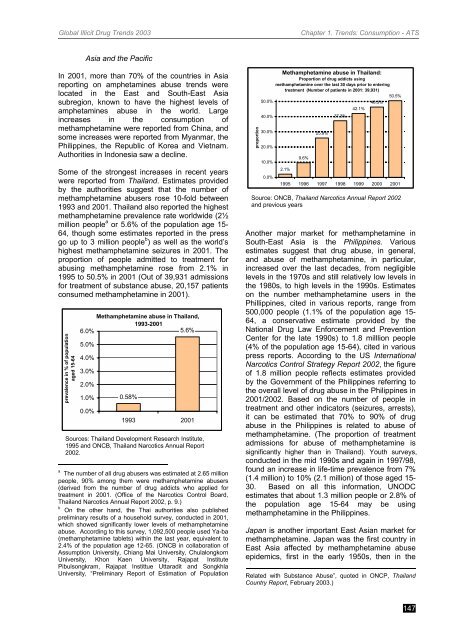global illicit drug trends 2003 - United Nations Office on Drugs and ...
global illicit drug trends 2003 - United Nations Office on Drugs and ...
global illicit drug trends 2003 - United Nations Office on Drugs and ...
You also want an ePaper? Increase the reach of your titles
YUMPU automatically turns print PDFs into web optimized ePapers that Google loves.
Global Illicit Drug Trends <str<strong>on</strong>g>2003</str<strong>on</strong>g><br />
Chapter 1. Trends: C<strong>on</strong>sumpti<strong>on</strong> - ATS<br />
Asia <strong>and</strong> the Pacific<br />
In 2001, more than 70% of the countries in Asia<br />
reporting <strong>on</strong> amphetamines abuse <str<strong>on</strong>g>trends</str<strong>on</strong>g> were<br />
located in the East <strong>and</strong> South-East Asia<br />
subregi<strong>on</strong>, known to have the highest levels of<br />
amphetamines abuse in the world. Large<br />
increases in the c<strong>on</strong>sumpti<strong>on</strong> of<br />
methamphetamine were reported from China, <strong>and</strong><br />
some increases were reported from Myanmar, the<br />
Philippines, the Republic of Korea <strong>and</strong> Vietnam.<br />
Authorities in Ind<strong>on</strong>esia saw a decline.<br />
Some of the str<strong>on</strong>gest increases in recent years<br />
were reported from Thail<strong>and</strong>. Estimates provided<br />
by the authorities suggest that the number of<br />
methamphetamine abusers rose 10-fold between<br />
1993 <strong>and</strong> 2001. Thail<strong>and</strong> also reported the highest<br />
methamphetamine prevalence rate worldwide (2½<br />
milli<strong>on</strong> people a or 5.6% of the populati<strong>on</strong> age 15-<br />
64, though some estimates reported in the press<br />
go up to 3 milli<strong>on</strong> people b ) as well as the world’s<br />
highest methamphetamine seizures in 2001. The<br />
proporti<strong>on</strong> of people admitted to treatment for<br />
abusing methamphetamine rose from 2.1% in<br />
1995 to 50.5% in 2001 (Out of 39,931 admissi<strong>on</strong>s<br />
for treatment of substance abuse, 20,157 patients<br />
c<strong>on</strong>sumed methamphetamine in 2001).<br />
a<br />
prevalence in % of populati<strong>on</strong><br />
aged 15-64<br />
Methamphetamine abuse in Thail<strong>and</strong>,<br />
1993-2001<br />
6.0%<br />
5.6%<br />
5.0%<br />
4.0%<br />
3.0%<br />
2.0%<br />
1.0%<br />
0.0%<br />
0.58%<br />
1993 2001<br />
Sources: Thail<strong>and</strong> Development Research Institute,<br />
1995 <strong>and</strong> ONCB, Thail<strong>and</strong> Narcotics Annual Report<br />
2002.<br />
The number of all <str<strong>on</strong>g>drug</str<strong>on</strong>g> abusers was estimated at 2.65 milli<strong>on</strong><br />
people, 90% am<strong>on</strong>g them were methamphetamine abusers<br />
(derived from the number of <str<strong>on</strong>g>drug</str<strong>on</strong>g> addicts who applied for<br />
treatment in 2001. (<str<strong>on</strong>g>Office</str<strong>on</strong>g> of the Narcotics C<strong>on</strong>trol Board,<br />
Thail<strong>and</strong> Narcotics Annual Report 2002, p. 9.)<br />
b<br />
On the other h<strong>and</strong>, the Thai authorities also published<br />
preliminary results of a household survey, c<strong>on</strong>ducted in 2001,<br />
which showed significantly lower levels of methamphetamine<br />
abuse. According to this survey, 1,092,500 people used Ya-ba<br />
(methamphetamine tablets) within the last year, equivalent to<br />
2.4% of the populati<strong>on</strong> age 12-65. (ONCB in collaborati<strong>on</strong> of<br />
Assumpti<strong>on</strong> University, Chiang Mai University, Chulal<strong>on</strong>gkorn<br />
University, Kh<strong>on</strong> Kaen University, Rajapat Institute<br />
Pibuls<strong>on</strong>gkram, Rajapat Instittue Uttaradit <strong>and</strong> S<strong>on</strong>gkhla<br />
University, “Preliminary Report of Estimati<strong>on</strong> of Populati<strong>on</strong><br />
proporti<strong>on</strong><br />
Methamphetamine abuse in Thail<strong>and</strong>:<br />
Proporti<strong>on</strong> of <str<strong>on</strong>g>drug</str<strong>on</strong>g> addicts using<br />
methamphetamine over the last 30 days prior to entering<br />
treatment (Number of patients in 2001: 39,931)<br />
50.5%<br />
50.0%<br />
46.3%<br />
42.1%<br />
40.0%<br />
37.3%<br />
30.0%<br />
20.0%<br />
10.0%<br />
0.0%<br />
2.1%<br />
9.6%<br />
25.9%<br />
1995 1996 1997 1998 1999 2000 2001<br />
Source: ONCB, Thail<strong>and</strong> Narcotics Annual Report 2002<br />
<strong>and</strong> previous years<br />
Another major market for methamphetamine in<br />
South-East Asia is the Philippines. Various<br />
estimates suggest that <str<strong>on</strong>g>drug</str<strong>on</strong>g> abuse, in general,<br />
<strong>and</strong> abuse of methamphetamine, in particular,<br />
increased over the last decades, from negligible<br />
levels in the 1970s <strong>and</strong> still relatively low levels in<br />
the 1980s, to high levels in the 1990s. Estimates<br />
<strong>on</strong> the number methamphetamine users in the<br />
Phillippines, cited in various reports, range from<br />
500,000 people (1.1% of the populati<strong>on</strong> age 15-<br />
64, a c<strong>on</strong>servative estimate provided by the<br />
Nati<strong>on</strong>al Drug Law Enforcement <strong>and</strong> Preventi<strong>on</strong><br />
Center for the late 1990s) to 1.8 millli<strong>on</strong> people<br />
(4% of the populati<strong>on</strong> age 15-64), cited in various<br />
press reports. According to the US Internati<strong>on</strong>al<br />
Narcotics C<strong>on</strong>trol Strategy Report 2002, the figure<br />
of 1.8 milli<strong>on</strong> people reflects estimates provided<br />
by the Government of the Philippines referring to<br />
the overall level of <str<strong>on</strong>g>drug</str<strong>on</strong>g> abuse in the Philippines in<br />
2001/2002. Based <strong>on</strong> the number of people in<br />
treatment <strong>and</strong> other indicators (seizures, arrests),<br />
it can be estimated that 70% to 90% of <str<strong>on</strong>g>drug</str<strong>on</strong>g><br />
abuse in the Philippines is related to abuse of<br />
methamphetamine. (The proporti<strong>on</strong> of treatment<br />
admissi<strong>on</strong>s for abuse of methamphetamine is<br />
significantly higher than in Thail<strong>and</strong>). Youth surveys,<br />
c<strong>on</strong>ducted in the mid 1990s <strong>and</strong> again in 1997/98,<br />
found an increase in life-time prevalence from 7%<br />
(1.4 milli<strong>on</strong>) to 10% (2.1 milli<strong>on</strong>) of those aged 15-<br />
30. Based <strong>on</strong> all this informati<strong>on</strong>, UNODC<br />
estimates that about 1.3 milli<strong>on</strong> people or 2.8% of<br />
the populati<strong>on</strong> age 15-64 may be using<br />
methamphetamine in the Philippines.<br />
Japan is another important East Asian market for<br />
methamphetamine. Japan was the first country in<br />
East Asia affected by methamphetamine abuse<br />
epidemics, first in the early 1950s, then in the<br />
Related with Substance Abuse”, quoted in ONCP, Thail<strong>and</strong><br />
Country Report, February <str<strong>on</strong>g>2003</str<strong>on</strong>g>.)<br />
147
















